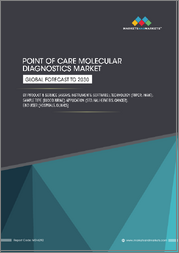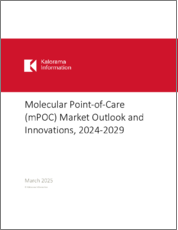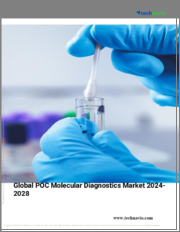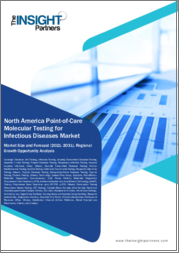
|
시장보고서
상품코드
1808376
POC(Point of Care) 분자진단 시장 : 제품 유형, 기술, 용도, 최종사용자별 - 세계 예측(2025-2030년)Point of Care Molecular Diagnostics Market by Product Type, Technology, Application, End User - Global Forecast 2025-2030 |
||||||
POC(Point of Care) 분자진단 시장은 2024년에는 52억 6,000만 달러로 평가되었습니다. 2025년에 56억 4,000만 달러에 이르고, CAGR 7.42%로 성장하여 2030년에는 80억 9,000만 달러에 달할 것으로 예측됩니다.
| 주요 시장 통계 | |
|---|---|
| 기준 연도 : 2024년 | 52억 6,000만 달러 |
| 추정 연도 : 2025년 | 56억 4,000만 달러 |
| 예측 연도 : 2030년 | 80억 9,000만 달러 |
| CAGR(%) | 7.42% |
의료 현장의 임상적 의사결정을 강화하는 신속한 POC(Point-of-Care) 분자진단으로 환자 중심 치료의 미래를 열어가다.
POC(Point-of-Care) 분자진단은 신속하고 정확한 분산형 검사를 가능하게 함으로써 환자 치료 제공에 변화를 가져오고 있습니다. 소형화된 핵산 증폭 시스템의 도입과 디지털 연결의 결합으로 중앙 집중식 검사실에서 침대 옆 검사 환경으로의 전환이 가속화되고 있습니다. 이러한 전환을 통해 임상의는 필요한 시점에 정보에 입각한 의사결정을 내릴 수 있고, 시간을 단축하고, 치료 경로를 최적화할 수 있습니다.
기술 혁신과 의료 전달 모델의 변화에 따른 POC 분자진단의 급속한 진화를 그립니다.
최근 POC(Point-of-Care) 분자진단의 생태계를 재구축하는 눈부신 기술 발전이 이루어지고 있습니다. 마이크로플루이딕스 칩의 설계와 시약 배합의 혁신은 분석 시간을 획기적으로 단축하여 몇 시간이 아닌 몇 분 안에 중요한 결정을 내릴 수 있게 해줍니다. 동시에 휴대용 하드웨어와 클라우드 기반 데이터 플랫폼의 통합으로 분산형 검사 시설과 중앙 검사실 네트워크의 원활한 연결이 가능해졌습니다. 그 결과, 임상의는 환자의 병력 및 집단 건강 지표와 함께 실용적인 검사 결과에 즉각적으로 접근할 수 있는 이점을 누릴 수 있습니다.
2025년 미국 관세 조치가 POC(Point-of-Care) 분자진단 의약품공급망과 비용 구조에 미치는 누적 영향 평가
미국의 2025년 강화된 관세 조치 발동은 POC 분자진단 의약품 공급업체와 최종 사용자에게 새로운 과제를 가져왔습니다. 검사 장비는 소모품인 시약 및 키트와 함께 수입 관세 인상에 직면하여 비용 구조에 직접적인 영향을 미칩니다. 이에 대응하기 위해 각 제조업체들은 생산의 현지화 및 대체 조달 계약 확보에 박차를 가하고 있으며, 이를 통해 수익률 하락 리스크를 줄이고 있습니다.
POC(Point-of-Care) 분자진단 시장의 제품 유형별 기술 용도별 및 최종 사용자별 주요 세분화 인사이트 파악하기
제품 카테고리를 종합적으로 살펴보면, 디자인과 휴대성의 지속적인 혁신으로 인해 기기 판매가 플랫폼 도입의 핵심으로 계속 작용하고 있음을 알 수 있습니다. 동시에 멀티플렉스 패널과 신규 바이오마커를 포함한 분석 메뉴의 확대에 따라 시약 및 키트 수요도 견조하게 유지되고 있습니다. 한편, 소프트웨어 제품은 검사실과 케어 네트워크가 독립형 하드웨어보다 데이터 분석과 원활한 상호 운용성을 우선시하면서 인기를 끌고 있습니다.
미국, 중동/아프리카, 아시아태평양의 POC 보급을 형성하는 지역적 역학관계에 대해 알아봅니다.
북미와 남미에서는 헬스케어 인프라에 대한 지속적인 투자와 우호적인 규제 환경으로 인해 도시와 농촌 모두에서 POC 도입이 가속화되고 있습니다. 연방정부가 코로나19 대응을 강화하기 위해 신속한 검사 개발을 위한 자금을 지원하는 한편, 민간 의료 네트워크는 외래 진료 및 지역 의료 센터의 현장 진료(Point of Care) 기능을 지속적으로 확장하고 있습니다.
파트너십, 합병, 제품 개발을 통해 POC(Point-of-Care) 분자진단 의약품의 혁신을 주도하는 주요 기업들의 전략적 움직임을 살펴봅니다.
업계를 선도하는 기업들은 분자진단 포트폴리오를 확대하기 위해 전략적 제휴 및 인수를 우선순위에 두고 있습니다. 주요 진단약 개발 기업들은 자체 분석 화학을 공동 개발하고, 공급망을 간소화하기 위해 전문 시약 제조업체와 파트너십을 맺고 있습니다. 동시에 분산된 검사 네트워크의 전체 데이터 통합 능력을 높이기 위해 많은 기업들이 소프트웨어 분석 기업의 볼트온 인수를 발표했습니다.
Point of Care 분자진단의 기회를 활용하고 경쟁 우위를 강화하기 위해 업계 리더를 위한 실행 가능한 권고안 마련
신속한 분자 검사에 대한 수요 증가에 대응하기 위해 업계 리더들은 모듈식 분석의 확장을 지원하는 유연한 플랫폼 아키텍처에 투자해야 합니다. 다양한 시약 카트리지에 대응할 수 있는 시스템을 설계함으로써 기업은 새로운 병원체 위협이나 변화하는 임상적 우선순위에 신속하게 대응할 수 있습니다. 마찬가지로 중요한 것은 시약 제조업체와의 전략적 제휴를 통해 고품질의 화학물질을 안정적으로 공급받는 것입니다.
종합적이고 신뢰할 수 있는 POC 분자진단 통찰력을 위한 분석을 뒷받침하는 엄격한 연구 방법론에 대해 자세히 알아보기.
이 분석은 여러 지역의 고위 경영진, 실험실 책임자 및 임상 최종 사용자에 대한 심층적인 1차 인터뷰를 결합한 엄격한 조사 프레임워크를 기반으로 합니다. 이러한 대화를 통해 POC 용도에 특화된 채택 촉진요인, 기술적 선호도, 운영상의 과제에 대한 직접적인 통찰력을 얻을 수 있었습니다.
현대 헬스케어에서 현장 분자진단의 혁신 가능성과 전략적 중요성에 대한 결론적 관점.
POC(Point-of-Care) 분자진단은 기술 혁신, 임상적 필요성, 경제적 실용성의 교차점에 위치합니다. 플랫폼이 더욱 컴팩트하고 사용하기 쉬워지고 디지털로 연결됨에 따라 진단 워크플로우를 재정의하고 다양한 의료 환경에서 환자 결과를 개선할 수 있는 잠재력을 가지고 있습니다.
목차
제1장 서문
제2장 조사 방법
제3장 주요 요약
제4장 시장 개요
제5장 시장 역학
제6장 시장 인사이트
- Porter's Five Forces 분석
- PESTEL 분석
제7장 미국 관세의 누적 영향 2025
제8장 POC(Point of Care) 분자진단 시장 : 제품 유형별
- 기기
- 시약 및 키트
- 소프트웨어
제9장 POC(Point of Care) 분자진단 시장 : 기술별
- 유전자 배열에 근거한다
- 하이브리드화 기반
- 등온 핵산 증폭 기술(INAAT)
- 마이크로어레이 기반
- PCR 기반
제10장 POC(Point of Care) 분자진단 시장 : 용도별
- 심장병학
- 유전자 검사
- 캐리어 스크리닝
- 신생아 스크리닝
- 산전 검사
- 감염증
- 위장 감염증
- 호흡기 감염증
- 성감염증
- 열대병
- 종양학
- 액체생검
- 변이 프로파일링
- 종양 유전자 패널
제11장 POC(Point of Care) 분자진단 시장 : 최종사용자별
- 클리닉
- 진단실험실
- 가정치료 환경
- 병원
제12장 아메리카의 POC(Point of Care) 분자진단 시장
- 미국
- 캐나다
- 멕시코
- 브라질
- 아르헨티나
제13장 유럽, 중동 및 아프리카의 POC(Point of Care) 분자진단 시장
- 영국
- 독일
- 프랑스
- 러시아
- 이탈리아
- 스페인
- 아랍에미리트(UAE)
- 사우디아라비아
- 남아프리카공화국
- 덴마크
- 네덜란드
- 카타르
- 핀란드
- 스웨덴
- 나이지리아
- 이집트
- 튀르키예
- 이스라엘
- 노르웨이
- 폴란드
- 스위스
제14장 아시아태평양의 POC(Point of Care) 분자진단 시장
- 중국
- 인도
- 일본
- 호주
- 한국
- 인도네시아
- 태국
- 필리핀
- 말레이시아
- 싱가포르
- 베트남
- 대만
제15장 경쟁 구도
- 시장 점유율 분석, 2024
- FPNV 포지셔닝 매트릭스, 2024
- 경쟁 분석
- Abbott Laboratories
- Becton, Dickinson and Company
- ACON LABS INC.
- Binx Health, inc.
- bioMerieux SA
- Cardinal Health, Inc.
- Chembio Diagnostics Inc.
- Co-Diagnostics, Inc.
- Danaher Corporation
- DiaSorin S.p.A
- EKF Diagnostics Holdings
- FHoffmann-La Roche AG
- Genomadix Inc. by LuminUltra Technologies Ltd.
- Henry Schein, Inc.
- Meridian Bioscience, Inc.
- Novartis AG
- OraSure Technologies, Inc.
- Pfizer, Inc.
- QIAGEN N.V.
- Quidel Corporation
- SD Biosensor
- Sekisui Diagnostics
- SHUWEN BIOTECH CO., LTD
- Siemens Healthineers AG
- Sysmex Corporation
- Thermo Fisher Scientific Inc.
제16장 리서치 AI
제17장 리서치 통계
제18장 리서치 컨택트
제19장 리서치 기사
제20장 부록
LSH 25.09.19The Point of Care Molecular Diagnostics Market was valued at USD 5.26 billion in 2024 and is projected to grow to USD 5.64 billion in 2025, with a CAGR of 7.42%, reaching USD 8.09 billion by 2030.
| KEY MARKET STATISTICS | |
|---|---|
| Base Year [2024] | USD 5.26 billion |
| Estimated Year [2025] | USD 5.64 billion |
| Forecast Year [2030] | USD 8.09 billion |
| CAGR (%) | 7.42% |
Unlocking the Future of Patient-Centered Care Through Rapid Point of Care Molecular Diagnostics That Enhance Clinical Decision Making Across Healthcare Settings
Point of care molecular diagnostics is transforming the delivery of patient care by enabling rapid, accurate, and decentralized testing. The introduction of miniaturized nucleic acid amplification systems combined with digital connectivity has accelerated the shift from centralized laboratories to bedside testing environments. This transition empowers clinicians to make informed decisions at the point of need, reducing turnaround times and optimizing treatment pathways.
Emerging assay formats leverage isothermal amplification, microfluidics, and integrated cartridge-based workflows to simplify sample preparation and analysis. As a result, healthcare professionals can detect infectious pathogens, genetic mutations, and oncological biomarkers in a fraction of the time required by traditional laboratory platforms. This evolution aligns with the broader trend toward personalized medicine, where diagnostic insights drive targeted therapies and improve clinical outcomes.
Furthermore, evolving reimbursement frameworks and regulatory guidelines have catalyzed the adoption of these devices in diverse care settings. Strategic collaborations between diagnostic developers, healthcare institutions, and digital health companies are fostering interoperability and data integration, creating an ecosystem that supports real-time surveillance and longitudinal patient monitoring.
The lessons learned from global pandemic responses have underscored the critical importance of rapid molecular detection in controlling outbreaks and mitigating public health risks. By deploying portable diagnostic units in field settings and resource-limited environments, stakeholders can identify and contain emerging threats before they spread. Consequently, this capability not only enhances the resilience of healthcare systems but also supports broader public health initiatives aimed at disease surveillance and prevention.
Charting the Rapid Evolution of Point of Care Molecular Diagnostics Driven by Technological Innovation and Shifting Healthcare Delivery Models
Recent years have witnessed remarkable technological advances that are reshaping the point of care molecular diagnostics ecosystem. Innovations in microfluidic chip design and reagent formulation have dramatically reduced assay turnaround times, allowing critical decisions to be made within minutes rather than hours. Simultaneously, the integration of portable hardware with cloud-based data platforms is enabling seamless connectivity between decentralized test sites and central laboratory networks. As a result, clinicians benefit from immediate access to actionable test results alongside patient histories and population health metrics.
Concurrently, the rise of machine learning and artificial intelligence has begun to inform assay interpretation and workflow optimization. Predictive algorithms can now help flag inconsistent assay outputs, standardize quality control, and even suggest differential diagnoses based on molecular signatures. These capabilities not only improve analytical accuracy but also reduce the burden on healthcare professionals, who face increasing pressures related to staffing shortages and rising case volumes.
Regulatory bodies and payers are responding to these shifts by streamlining approval pathways and updating reimbursement codes to reflect the value proposition of rapid molecular assays. In parallel, healthcare systems are exploring value-based care models that incentivize the reduction of hospital stays and readmissions through timely diagnostics. Taken together, these transformative forces are charting a new era in which point of care molecular testing becomes an indispensable component of efficient, patient-centered healthcare delivery.
Assessing the Cumulative Impact of 2025 United States Tariff Measures on Point of Care Molecular Diagnostics Supply Chains and Cost Structures
The imposition of enhanced tariff measures by the United States in 2025 has introduced a new set of challenges for suppliers and end users of point of care molecular diagnostics. Instruments, along with their consumable reagents and kits, are facing increased import duties that directly impact cost structures. In response, manufacturers are accelerating efforts to localize production and secure alternative sourcing agreements, thereby mitigating the risk of margin erosion.
As reagents become subject to higher duties, distributors and diagnostic laboratories are reevaluating inventory strategies and pricing models. Some organizations have begun renegotiating long-term contracts to achieve volume-based discounts or to shift toward vendor-managed inventory solutions that reduce holding costs. Despite these adjustments, smaller clinics and home care providers may experience delayed adoption of new assays due to constrained budgets and tighter procurement cycles.
Yet, amid these headwinds, a silver lining has emerged: renewed interest in domestic supply chain resilience. Stakeholders are exploring partnerships with contract manufacturing organizations and establishing regional distribution hubs to shorten lead times and reduce exposure to global logistics disruptions. Ultimately, the 2025 tariff environment is prompting a strategic realignment across the value chain as industry participants strive to balance cost pressures against the imperative for rapid, reliable molecular diagnostics.
Illuminating Key Segmentation Insights Across Product Types Technologies Applications and End Users in the Point of Care Molecular Diagnostics Market
A comprehensive examination of product categories reveals that instrument sales continue to serve as a cornerstone for platform adoption, driven by ongoing innovations in design and portability. At the same time, reagents and kits are experiencing robust demand as assay menus expand to include multiplex panels and novel biomarkers. Software offerings, meanwhile, are gaining traction as laboratories and care networks prioritize data analytics and seamless interoperability over standalone hardware.
When analyzing technological underpinnings, genetic sequencing-based approaches have begun to penetrate the point of care arena by offering comprehensive genomic insights in near real time. Hybridization-based methods maintain their stronghold in targeted applications, while isothermal nucleic acid amplification technology provides cost-effective, rapid detection in resource-constrained environments. Furthermore, microarray-based solutions are carving out niches in specialized diagnostics, and PCR-based platforms remain the predominant choice for high-sensitivity assays.
In terms of clinical applications, cardiology assays are emerging as a critical tool for identifying acute cardiac events and guiding treatment pathways. Genetic testing has diversified beyond traditional carrier screening to encompass newborn and prenatal diagnostics, delivering actionable information earlier in the patient journey. Infectious disease testing continues to evolve with expanded panels for gastrointestinal, respiratory, sexually transmitted, and tropical pathogens. Oncology has witnessed significant growth in liquid biopsy techniques, mutation profiling, and onco-gene panels that support personalized cancer management.
Finally, end user dynamics underscore a shift toward decentralized models. Clinics are investing in compact systems to deliver same-visit results, whereas diagnostic laboratories reinforce centralized capabilities with point of care extensions. Home care settings are piloting user-friendly devices that enable remote monitoring, and hospitals are integrating molecular diagnostics into emergency and surgical workflows to enhance patient throughput.
Revealing Regional Dynamics Shaping Adoption of Point of Care Molecular Diagnostics Across the Americas Europe Middle East and Africa and Asia-Pacific
In the Americas, sustained investment in healthcare infrastructure and a supportive regulatory environment have accelerated the deployment of point of care molecular diagnostics across both urban and rural settings. Federal initiatives aimed at strengthening pandemic preparedness have unlocked funding for rapid test development, while private healthcare networks continue to expand point of care capabilities within ambulatory care and community health centers.
Across Europe Middle East and Africa, diverse regulatory landscapes present both challenges and opportunities. In Western Europe, harmonized approval processes and robust reimbursement schemes have fostered early adoption of advanced molecular platforms. Meanwhile, in emerging markets, flexible pricing models and public-private partnerships are instrumental in scaling assay deployment. Regions facing infrastructure limitations are increasingly leveraging portable, battery-powered devices to bridge diagnostic gaps.
Asia-Pacific is witnessing some of the fastest growth rates globally, fueled by large patient populations and proactive government initiatives focused on disease surveillance. Economic growth in key markets has led to enhanced healthcare spending, while innovative payment models-such as subscription-based reagent plans-are unlocking access in mid-tier hospitals and clinics. Additionally, collaborations with local manufacturers are reducing costs and expediting market entry for new assays.
Uncovering Strategic Moves of Leading Players Driving Innovation in Point of Care Molecular Diagnostics Through Partnerships Mergers and Product Development
Leading industry participants are prioritizing strategic collaborations and acquisitions to broaden their point of care molecular diagnostics portfolios. Major diagnostic developers are forging partnerships with specialty reagent producers to co-develop proprietary assay chemistries and streamline supply chains. Simultaneously, a number of players have announced bolt-on acquisitions of software analytics firms to elevate data integration capabilities across decentralized testing networks.
On the innovation front, several organizations are piloting next-generation sequencing modules that can be tethered to mobile workstations, thereby bringing comprehensive genomic profiling to outpatient settings. Other companies are doubling down on isothermal amplification technology, aiming to deliver low-cost, high-throughput solutions amenable to field deployment in emerging markets. Across the board, differentiated assay sensitivity and specificity have become key competitive levers.
Moreover, an increasing emphasis on digital health has prompted diagnostic vendors to bundle connectivity services, offering cloud-based result management and remote quality-control dashboards. This shift is reshaping go-to-market strategies as customers demand turnkey solutions that encompass hardware, consumables, and software under unified service agreements.
Formulating Actionable Recommendations for Industry Leaders to Capitalize on Opportunities in Point of Care Molecular Diagnostics and Enhance Competitive Advantage
To capitalize on the growing demand for rapid molecular testing, industry leaders should invest in flexible platform architectures that support modular assay expansion. By designing systems capable of accommodating a wide range of reagent cartridges, organizations can swiftly respond to emerging pathogen threats and shifting clinical priorities. Equally important is the cultivation of strategic alliances with reagent manufacturers to ensure a reliable supply of high-quality chemistries.
Furthermore, aligning product development roadmaps with evolving regulatory frameworks and reimbursement pathways will expedite market access. Cross-functional task forces that include regulatory experts, clinical liaisons, and health economics professionals can proactively address compliance requirements and articulate value propositions to payers. In parallel, establishing training programs and remote support capabilities will enhance user adoption and minimize operator errors in decentralized environments.
Finally, enhancing supply chain resilience through the localization of key manufacturing processes and the creation of regional distribution hubs will mitigate the impact of future trade disruptions. Coupling these efforts with data-driven demand forecasting tools will optimize inventory levels and reduce lead times. By adopting these measures, decision-makers can secure a competitive edge while delivering reliable point of care diagnostics to a broad spectrum of end users.
Detailing the Rigorous Research Methodology Underpinning the Analysis for Comprehensive and Reliable Point of Care Molecular Diagnostics Insights
This analysis is grounded in a rigorous research framework that combines in-depth primary interviews with senior executives, laboratory directors, and clinical end users across multiple geographies. These conversations provided first-hand insights into adoption drivers, technology preferences, and operational challenges specific to point of care molecular applications.
Secondary research complemented these qualitative findings by drawing on peer-reviewed publications, regulatory filings, and corporate release documents. Data from industry whitepapers and public health agency reports were triangulated against proprietary databases to validate trends and ensure consistency. Each data point underwent cross-verification through multiple sources to maintain accuracy and objectivity.
Our segmentation approach aligns product types, technology modalities, clinical applications, and end user categories to deliver a nuanced understanding of market dynamics. Regional analyses were informed by economic indicators, healthcare spending patterns, and local regulatory landscapes. Key performance metrics and thematic insights were further tested through scenario planning exercises to assess resilience under varying market conditions.
Quality control measures-including independent peer reviews, editorial audits, and methodological sanity checks-ensure that findings meet the highest standards of reliability. The resulting perspectives offer stakeholders a robust foundation for strategic decision-making and informed investment in point of care molecular diagnostics.
Concluding Perspectives on the Transformative Potential and Strategic Imperatives of Point of Care Molecular Diagnostics in Modern Healthcare
Point of care molecular diagnostics stands at the intersection of technological innovation, clinical necessity, and economic pragmatism. As platforms become more compact, user friendly, and digitally connected, they have the potential to redefine diagnostic workflows and enhance patient outcomes across diverse care settings.
Industry participants must remain vigilant in adapting to shifting regulatory requirements, supply chain challenges, and evolving reimbursement landscapes. By embracing strategic partnerships, investing in modular architectures, and aligning closely with clinical stakeholders, organizations can harness the transformative power of rapid molecular testing. Ultimately, those who proactively integrate these solutions into healthcare delivery models will lead the migration toward faster, more personalized care.
Table of Contents
1. Preface
- 1.1. Objectives of the Study
- 1.2. Market Segmentation & Coverage
- 1.3. Years Considered for the Study
- 1.4. Currency & Pricing
- 1.5. Language
- 1.6. Stakeholders
2. Research Methodology
- 2.1. Define: Research Objective
- 2.2. Determine: Research Design
- 2.3. Prepare: Research Instrument
- 2.4. Collect: Data Source
- 2.5. Analyze: Data Interpretation
- 2.6. Formulate: Data Verification
- 2.7. Publish: Research Report
- 2.8. Repeat: Report Update
3. Executive Summary
4. Market Overview
- 4.1. Introduction
- 4.2. Market Sizing & Forecasting
5. Market Dynamics
- 5.1. Integration of CRISPR-based detection methods into portable point-of-care platforms for rapid pathogen identification
- 5.2. Adoption of smartphone-enabled molecular diagnostic devices for decentralized patient testing
- 5.3. Implementation of AI-driven predictive analytics in point-of-care molecular diagnostic result interpretation
- 5.4. Expansion of multiplex PCR assays for simultaneous detection of multiple infectious diseases at point of care
- 5.5. Development of isothermal amplification technologies for low-cost, field-deployable molecular testing solutions
- 5.6. Regulatory approvals accelerating commercialization of next-generation cartridge-based molecular diagnostic systems
- 5.7. Partnerships between diagnostics firms and telehealth providers to streamline remote molecular testing workflows
- 5.8. Growth of home-based molecular testing kits for at-home infectious disease monitoring and management
- 5.9. Emergence of paper-based microfluidic platforms for ultra-low-cost point-of-care molecular diagnostics in resource-limited settings
- 5.10. Increasing demand for rapid oncology biomarker assays in outpatient clinics and decentralized care settings
6. Market Insights
- 6.1. Porter's Five Forces Analysis
- 6.2. PESTLE Analysis
7. Cumulative Impact of United States Tariffs 2025
8. Point of Care Molecular Diagnostics Market, by Product Type
- 8.1. Introduction
- 8.2. Instruments
- 8.3. Reagents & Kits
- 8.4. Software
9. Point of Care Molecular Diagnostics Market, by Technology
- 9.1. Introduction
- 9.2. Genetic Sequencing-based
- 9.3. Hybridization-based
- 9.4. Isothermal Nucleic Acid Amplification Technology (INAAT)
- 9.5. Microarray-based
- 9.6. PCR-based
10. Point of Care Molecular Diagnostics Market, by Application
- 10.1. Introduction
- 10.2. Cardiology
- 10.3. Genetic Testing
- 10.3.1. Carrier Screening
- 10.3.2. Newborn Screening
- 10.3.3. Prenatal Testing
- 10.4. Infectious Disease
- 10.4.1. Gastrointestinal Infections
- 10.4.2. Respiratory Infections
- 10.4.3. Sexually Transmitted Infections
- 10.4.4. Tropical Diseases
- 10.5. Oncology
- 10.5.1. Liquid Biopsy
- 10.5.2. Mutation Profiling
- 10.5.3. Oncogene Panel
11. Point of Care Molecular Diagnostics Market, by End User
- 11.1. Introduction
- 11.2. Clinics
- 11.3. Diagnostic Laboratories
- 11.4. Home Care Settings
- 11.5. Hospitals
12. Americas Point of Care Molecular Diagnostics Market
- 12.1. Introduction
- 12.2. United States
- 12.3. Canada
- 12.4. Mexico
- 12.5. Brazil
- 12.6. Argentina
13. Europe, Middle East & Africa Point of Care Molecular Diagnostics Market
- 13.1. Introduction
- 13.2. United Kingdom
- 13.3. Germany
- 13.4. France
- 13.5. Russia
- 13.6. Italy
- 13.7. Spain
- 13.8. United Arab Emirates
- 13.9. Saudi Arabia
- 13.10. South Africa
- 13.11. Denmark
- 13.12. Netherlands
- 13.13. Qatar
- 13.14. Finland
- 13.15. Sweden
- 13.16. Nigeria
- 13.17. Egypt
- 13.18. Turkey
- 13.19. Israel
- 13.20. Norway
- 13.21. Poland
- 13.22. Switzerland
14. Asia-Pacific Point of Care Molecular Diagnostics Market
- 14.1. Introduction
- 14.2. China
- 14.3. India
- 14.4. Japan
- 14.5. Australia
- 14.6. South Korea
- 14.7. Indonesia
- 14.8. Thailand
- 14.9. Philippines
- 14.10. Malaysia
- 14.11. Singapore
- 14.12. Vietnam
- 14.13. Taiwan
15. Competitive Landscape
- 15.1. Market Share Analysis, 2024
- 15.2. FPNV Positioning Matrix, 2024
- 15.3. Competitive Analysis
- 15.3.1. Abbott Laboratories
- 15.3.2. Becton, Dickinson and Company
- 15.3.3. ACON LABS INC.
- 15.3.4. Binx Health, inc.
- 15.3.5. bioMerieux SA
- 15.3.6. Cardinal Health, Inc.
- 15.3.7. Chembio Diagnostics Inc.
- 15.3.8. Co-Diagnostics, Inc.
- 15.3.9. Danaher Corporation
- 15.3.10. DiaSorin S.p.A
- 15.3.11. EKF Diagnostics Holdings
- 15.3.12. FHoffmann-La Roche AG
- 15.3.13. Genomadix Inc. by LuminUltra Technologies Ltd.
- 15.3.14. Henry Schein, Inc.
- 15.3.15. Meridian Bioscience, Inc.
- 15.3.16. Novartis AG
- 15.3.17. OraSure Technologies, Inc.
- 15.3.18. Pfizer, Inc.
- 15.3.19. QIAGEN N.V.
- 15.3.20. Quidel Corporation
- 15.3.21. SD Biosensor
- 15.3.22. Sekisui Diagnostics
- 15.3.23. SHUWEN BIOTECH CO., LTD
- 15.3.24. Siemens Healthineers AG
- 15.3.25. Sysmex Corporation
- 15.3.26. Thermo Fisher Scientific Inc.



















